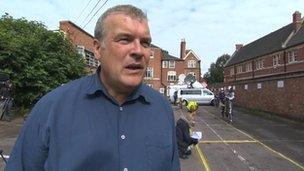Richard III's remains: Leicester car park dug up
- Published
The dig is to try to locate the remains of King Richard III who died at the Battle of Bosworth in 1485
A bid to find the remains of England's King Richard III is starting more than 500 years after his death on a Leicestershire battlefield.
A University of Leicester archaeological team is digging in the city's Grey Friars car park where they think he may have been buried.
King Richard III was killed at Bosworth in 1485 and his body taken to a Franciscan Friary in the city.
Over time, the exact location of the grave has been lost.
The project team said their work is "the first ever search for the lost grave of an anointed King of England".
'Long shot'
Richard III was crowned at Westminster Abbey in July 1483 and died in August 1485 fighting his enemies led by Henry Tudor.
He was the last English king to be killed in battle and the last Plantagenet king. He was followed by the Tudor kings Henry VII and Henry VIII.
Richard Buckley, of the University of Leicester archaeology service, said: "The big question for us is determining the whereabouts of the church on the site and also where in the church the body was buried.
"Although in many ways finding the remains of the king is a long shot, it is a challenge we shall undertake enthusiastically."
The team will use ground-penetrating radar to help find the best places to dig.
Philippa Langley, of the Richard III Society, said: "Richard III is a charismatic figure who attracts tremendous interest.
"Partly because he has been so much maligned in past centuries and partly because he occupies a pivotal place in English history.
"The continuing interest in Richard means that many fables have grown up around his grave.
"Although local people like Alderman Herrick in 1612 knew precisely where he was buried - and Herrick was able to show visitors a handsome stone pillar marking the king's grave in his garden - nevertheless at the same time unlikely stories were spread of Richard's bones being dug up and thrown into the river Soar.
"Other fables, equally discredited, claimed that his coffin was used as a horse trough."
'Exciting opportunity'
The Richard III Society works to defend the king's reputation, although many historians believe Richard was responsible for the murder of his young nephews, King Edward V and Prince Richard.

Archaeologist Richard Buckley admitted finding the king's remains under the car park was 'a challenge'
The "princes in the Tower", the sons of Richard's brother King Edward IV, disappeared while being kept in the Tower of London in 1483.
University of Leicester spokesman Richard Taylor said: "If remains are found that are suspected to be those of Richard III, they will be subject to DNA analysis at the University of Leicester where DNA fingerprinting was originally discovered."
If the royal remains are found during the two-week excavation, they will be reinterred at Leicester Cathedral, a team spokesman said.
Councillor Piara Singh Clair, of Leicester City Council, said: "Richard III is a key figure in the region's history.
"This is an exciting opportunity potentially to discover a missing piece of our historical jigsaw."